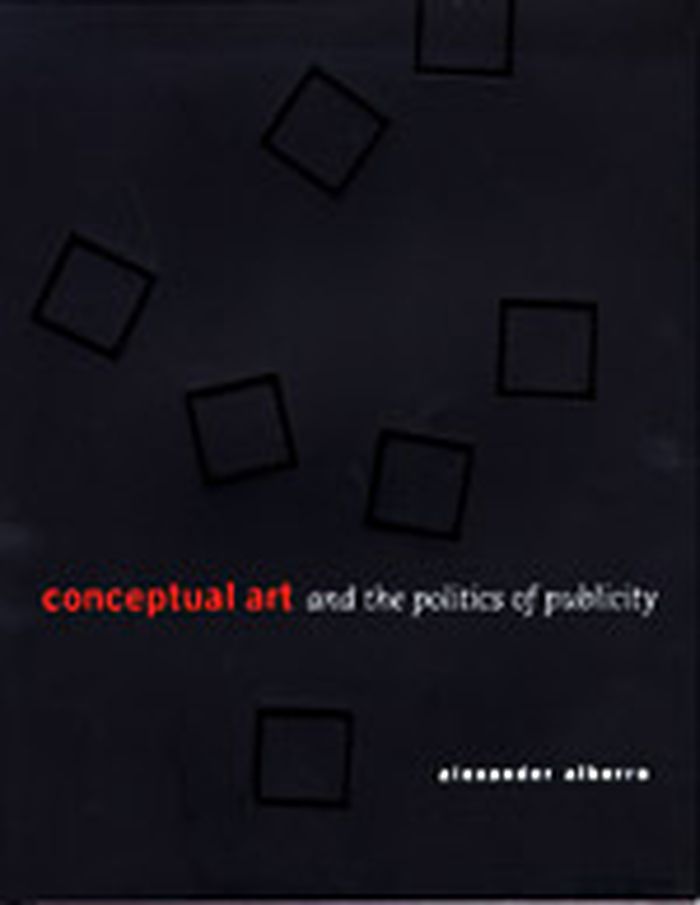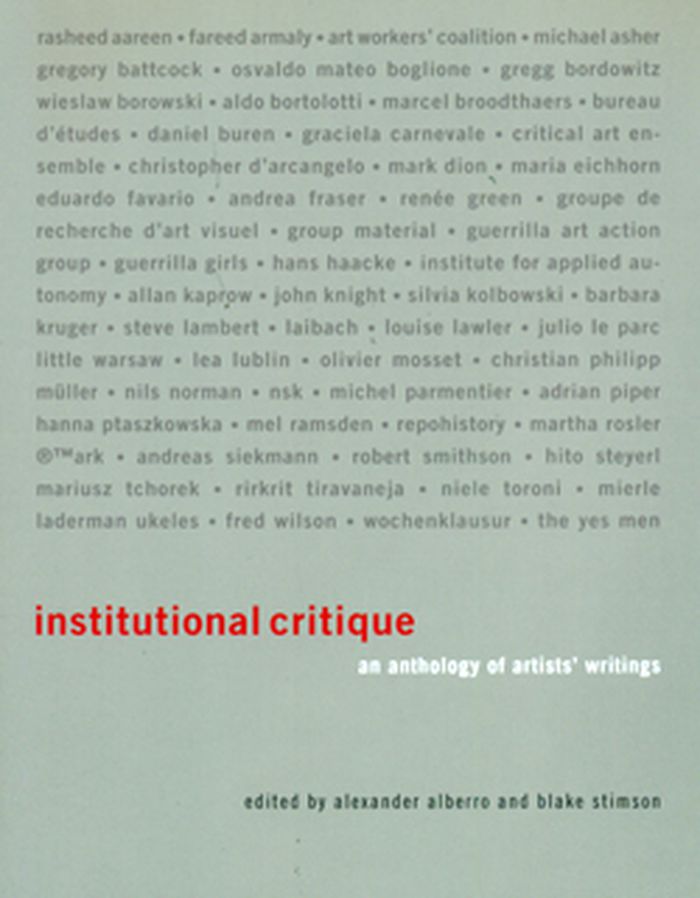$52.50
(disponible sur commande)
Résumé:
Conceptual art was one of the most influential art movements of the second half of the twentieth century. In this book Alexander Alberro traces its origins to the mid-1960s, when its principles were first articulated by the artists Dan Graham, Joseph Kosuth, Sol LeWitt, Lawrence Weiner, and others. One of Alberro's central arguments is that the conceptual art movement(...)
janvier 2003, Cambridge, Mass.
Conceptual art and the politics of publicity
Actions:
Prix:
$52.50
(disponible sur commande)
Résumé:
Conceptual art was one of the most influential art movements of the second half of the twentieth century. In this book Alexander Alberro traces its origins to the mid-1960s, when its principles were first articulated by the artists Dan Graham, Joseph Kosuth, Sol LeWitt, Lawrence Weiner, and others. One of Alberro's central arguments is that the conceptual art movement was founded not just by the artists but also by the dealer Seth Siegelaub. Siegelaub promoted the artists, curated groundbreaking shows, organized symposia and publications, and in many ways set the stage for another kind of entrepreneur: the freelance curator. Alberro examines both Siegelaub's role in launching the careers of artists who were making "something from nothing" and his tactful business practices, particularly in marketing and advertising. Alberro draws on close readings of artworks produced by key conceptual artists in the mid- to late 1960s. He places the movement in the social context of the rebellion against existing cultural institutions, as well as the increased commercialization and globalization of the art world. The book ends with a discussion of one of Siegelaub's most material and least ephemeral contributions, the Artist's Reserved Rights Transfer and Sale Agreement, which he wrote between 1969 and 1971. Designed to limit the inordinate control of collectors, galleries, and museums by increasing the artist's rights, the Agreement unwittingly codified the overlap between capitalism and the arts.
$46.95
(disponible sur commande)
Résumé:
Hans Haacke’s art articulates the interdependence of multiple elements. An artwork is not merely an object but is also its context—the economic, social, and political conditions of the art world and the world at large. Among his best-known works are MoMA-Poll (1970), which polled museumgoers on their opinions about Nelson Rockefeller and the Nixon administration’s(...)
Working conditions: the writings of Hans Haacke
Actions:
Prix:
$46.95
(disponible sur commande)
Résumé:
Hans Haacke’s art articulates the interdependence of multiple elements. An artwork is not merely an object but is also its context—the economic, social, and political conditions of the art world and the world at large. Among his best-known works are MoMA-Poll (1970), which polled museumgoers on their opinions about Nelson Rockefeller and the Nixon administration’s Indochina policy; Gallery-Goers’ Birthplace and Residence Profile (1969), which canvassed visitors to the Howard Wise Gallery in Manhattan; and the famously canceled 1971 solo exhibition at the Guggenheim Museum, which was meant to display, among other things, works on two New York real estate empires. This volume collects writings by Haacke that explain and document his practice. The texts, some of which have never before been published, run from straightforward descriptions to wide-ranging reflections and full-throated polemics. They include correspondence with MoMA and the Guggenheim and a letter refusing to represent the United States at the 1969 São Paulo Biennial; the title piece, “Working Conditions,” which discusses corporate influence on the art world; Haacke’s thinking about “real-time social systems”; and texts written for museum catalogs on various artworks, including GERMANIA, in the German Pavilion of the 1993 Venice Biennial; DER BEVÖLKERUNG (To the Population) of 2000 at the Berlin Reichstag; Mixed Messages, an exhibition of objects from the Victoria and Albert Museum (2001); and Gift Horse, unveiled on the fourth plinth in Trafalgar Square in 2015.
Théorie de l’art
$29.95
(disponible sur commande)
Résumé:
In 1975, a small group of enterprising, discontented members of Quebec's art community posed the question: "What do we know about contemporary art outside of Quebec, in Canada or abroad? Do we know what contemporary art exists in Montreal? How does information about art circulate?" By way of an answer, the artistically unconventional and theoretically cutting-edge(...)
Parachute : the anthology, vol. 1
Actions:
Prix:
$29.95
(disponible sur commande)
Résumé:
In 1975, a small group of enterprising, discontented members of Quebec's art community posed the question: "What do we know about contemporary art outside of Quebec, in Canada or abroad? Do we know what contemporary art exists in Montreal? How does information about art circulate?" By way of an answer, the artistically unconventional and theoretically cutting-edge magazine Parachute was launched, founded by Chantal Pontbriand and France Morin. Artists such as Jeff Wall, Bill Viola, Stan Douglas, Eija-Liisa Ahtila and many others had the first significant critical reception of their work in Parachute. Similarly, figures such as Douglas Crimp, Thomas Crow, Thierry de Duve, Georges Didi-Huberman, Hal Foster, Reesa Greenberg, Serge Guilbaut and Laura Mulvey published highly pertinent essays in the journal early on in their careers. The essays collected in this volume have been selected from the first 25 years of Parachute's publication history, from 1975 to 2000.
Théorie de l’art
$39.95
(disponible sur commande)
Résumé:
Institutional critique is an artistic practice that reflects critically on its own housing in galleries and museums and on the concept and social function of art itself. Such concerns have always been a part of modern art but took on new urgency at the end of the 1960s, when -driven by the social up heaval of the time and enabled by the tools and techniques of conceptual(...)
Institutional critique : an anthology of artists' writings
Actions:
Prix:
$39.95
(disponible sur commande)
Résumé:
Institutional critique is an artistic practice that reflects critically on its own housing in galleries and museums and on the concept and social function of art itself. Such concerns have always been a part of modern art but took on new urgency at the end of the 1960s, when -driven by the social up heaval of the time and enabled by the tools and techniques of conceptual art - institutional critique emerged as a genre. This anthology traces the development of institutional critique as an artistic concern from the 1960's to the present by gathering writings and representative art projects of artists from across Europe and throughout the Americas who developed and extended the genre.
Théorie de l’art



